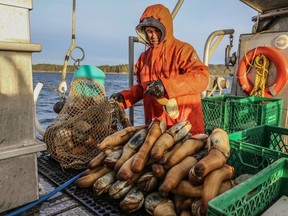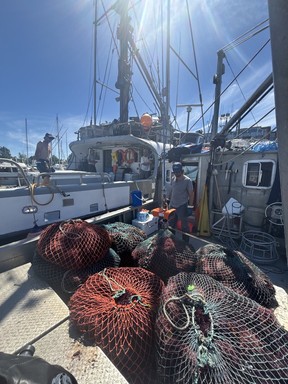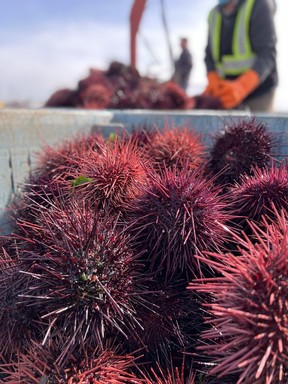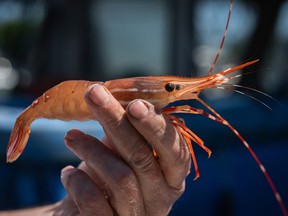The next spot prawn? The big push for B.C.'s bounty of geoducks, sea urchins and sea cucumbers
'Dive seafoods' are some of B.C.’s most prized culinary products, yet few of us have ever even tasted them

Article content
Reviews and recommendations are unbiased and products are independently selected. Postmedia may earn an affiliate commission from purchases made through links on this page.
Geoducks. Sea urchins. Sea cucumbers. These “dive seafoods” are some of B.C.’s most prized culinary products, yet few of us have ever even tasted them.
Partly that’s because they are also some of our most, as Prince William memorably noted, “presentationally challenged” foodstuffs.
“People are afraid of funny-looking things,” says chef Dez Lo, the local-seafood ambassador who was runner-up on Top Chef Canada season 10.
But mostly it’s because, for decades, about 95 per cent of the annual harvest has been shipped overseas, almost all of it to China, leaving very little for local consumers to enjoy.
Not any more.
“We randomly woke up one day in March and China had launched 25 per cent tariffs,” says Katie Lindsay, marketing manager of the Underwater Harvesters Association, which represents B.C.’s 55 geoduck and horse clam licence holders.
Overnight, the export market plummeted, affecting dozens of fishing families on this coast.
Now market diversification has become essential for survival. And the market that the newly formed B.C. Dive Fisheries Society is eyeing most of all is the one right here at home.
It’s hard to promote products few of us have ever tried, though, so they are hosting the Divers’ Catch Gala on Sept. 20, when an all-star lineup of chefs will be showcasing the versatility and deliciousness of B.C.’s dive-harvested seafood
And that’s just a start. As Bonnie Dennis, co-executive director of the B.C. Dive Fisheries Society, says. “Everyone is going toward market diversification, but that is not easy and it doesn’t happen overnight.”
Tariff trouble
While geoduck, sea urchin and sea cucumber are wildly different from each other, each of them is harvested by hand by licensed commercial divers, most of them from small family operations, including many Indigenous families.
As a result, the dive fishery is a profoundly sustainable one — it creates no pollutants, does no damage to the sea floor and leaves no bycatch — but it is a hard, dangerous and painstaking job that requires special skills often handed down from generation to generation.
And that makes the tariff blow feel harsh.
“We’re a third-generation fishing family. I know our family is directly impacted,” says Dennis, who is also the director of the Pacific Sea Cucumber Harvesters Association. “And I know there’s other folks on this coast who are in the same position.”

The tariffs announced by China in retaliation for Canada’s levy on Chinese EVs are just the latest setback for a fishery that survived the COVID-caused market slump in 2020, as well as the 2021 heat dome that killed more than an estimated billion sea creatures on this coast. But it’s the greatest crisis so far — and perhaps the greatest opportunity.
“When the tariffs were announced in March, the price of geoduck dropped by half. That came out of nowhere for us,” says Lindsay, who is a member of a second-generation geoduck-fishing family. “Over-dependence on China puts our fishing families at risk. With the U.S. situation, it seems Trump changes his mind every single day, but with China it’s a long journey to change their minds.”
It’s not like these fisheries weren’t already trying to diversify their markets. Each has its own association doing just that: In addition to geoduck’s UHA, the Pacific Sea Cucumber Harvesting Association oversees 85 commercial licence holders, and the Pacific Urchin Harvesters Association represents the 110 licence holders in B.C.’s red urchin fishery and 49 in the green urchin fishery.
But, as Lindsay notes: “There are so many barriers for building markets.” Among them is the challenge of getting dive seafoods to Canadian consumers outside the Vancouver area. “I have a lot of chefs trying to get their hands on the product … but our exporters don’t sell across Canada so they can’t get their hands on it,” she says.
And these are valuable fisheries. The geoduck export market is estimated to be about $50 million a year, sea urchin $21 million and sea cucumber around $15 million. All of that is at risk — and now other agricultural products, like canola, are subject to the tariff pinch, too.
“There are still small amounts of dive seafoods entering the Asian market, but at a very discounted price than in years previous,” Dennis says. “The big blow and the big feels were back in March. Seeing our other agricultural producers going through this now, it just breaks my heart.”
Luxury foods
Still, China’s loss might well be our gain. There’s good reason why the delicate flavours and unique textures of dive seafoods are so highly prized by those lucky enough to try them.
The geoduck, pronounced gooey-duck and also called king clam, is the world’s largest burrowing bivalve, native to the Pacific Northwest and known for its long, somewhat phallic siphon as well as its remarkable longevity — these giant clams can live more than 100 years.
Back in the 1970s, geoduck was so cheap it was served in B.C. Ferries’ clam chowder. Today it sells for $35 to $50 a pound. “That is a lot,” says Lo.
At that price, geoduck is definitely a luxury item, with a sweet flavour and crunchy texture. It’s typically sliced thin and served raw in Japanese sushi bars, where it is called mirugai, or blanched or lightly stir-fried in Chinese dishes.
“The preparation isn’t hard, but you need a delicate hand,” Lo says. “To thin-slice it the way we like for sashimi, you have to have very good skills.”
The spiky sea urchin also has an intimidating appearance, though in a very different way.
“You look at it and go, what is this, is it a weapon?” Lo says. “But once you try it, you can’t resist it. The creaminess and sweetness just melts in your mouth.”

Like geoduck, sea urchin is best served raw. Called “uni” in Japanese restaurants, its roe considered a great delicacy and is usually sold in tubs or trays.
Sea cucumbers are the least familiar to most consumers; they rarely appear on menus or in stores, although they can be found dried in some Chinese markets and some suppliers make it available, fresh or often frozen, to chefs.
It’s not just the flavour of the sea cucumber that makes it appealing. “It’s loaded with collagen so people eat it for the health benefits,” Dennis says. Adds Lo: “It’s good for your skin. That’s why I’m almost 50 and I have no wrinkles.”
While the gelatinous skin is often served in soup, the meat has a texture similar to calamari and is best blanched or stir-fried. For the Divers’ Catch Gala, for instance, Lo is serving it blanched in a fried won ton shell with “all the fixings for a traditional taco,” then drizzled with a Vietnamese-style nuoc cham sauce.
There are, it seems, plenty of exciting Asian culinary applications for these foods. But finding Western ways of preparing them — beyond chowder — will be essential to building a domestic market.
“Then (consumers) will be more inclined to buy and try,” says Lo. “But that’s where the seafood festivals are great, because you can try a little bit.”

The next spot prawn?
Two decades ago, there was another local seafood that was mostly exported and relatively unknown in this market. Then the Chefs’ Table Society created a festival to introduce it to consumers. It’s now become one of B.C.’s most treasured foods, with hungry consumers happily spending $25 a pound to buy it straight from fishing boats.
That product? The spot prawn, of course.
The Spot Prawn Festival in Vancouver and Victoria kicks off the season each May, alerting foodies around the province to look for these sweet, sustainable local crustaceans. The organizers of the Divers’ Catch Gala are using it as their own inspiration, even though Lindsay says: “Each of these products is pretty niche — it’s not your average spot prawn or halibut.”
Education will be key, teaching chefs how to prepare these foods, convincing consumers to order them from menus, encouraging all of us to “eat within our ecosystem,” as Dennis says. But first, these fishers just need British Columbians to try their precious seafoods and, with any luck, fall in love with them.
After all, as Lindsay says: “The Divers’ Catch Gala comes at a good time, but it’s not going to change things overnight.”
Then she adds: “There is potential for any and everything. It’s just building education and awareness. It’s a long game. One day it might be like spot prawns, who knows?”
About the Divers Catch Gala
The inaugural Divers Catch Gala will be held 6-10 p.m., Sept. 20, at The Deck at Radisson Blu in Richmond.
Presented by the B.C. Dive Fisheries Society, it features an all-star lineup of chefs presenting signature dishes made with geoduck, sea urchin and sea cucumber.
Among them: Ned Bell (Hatch Hospitality), Will Lew (Pacific Reach), Bobby Milheron (Homer St. Café and Bar, Maxine’s Cafe and Bar and Tableau Bar and Bistro), Dez Lo (Top Chef Canada, Luxe), Welbert Choi (F.I.S.H.), Alex Kim (Five Sails) and Bo Li (The Fish Man).
Tickets are $138.88. For more info, visit diverscatchbc.ca.














Postmedia is committed to maintaining a lively but civil forum for discussion. Please keep comments relevant and respectful. Comments may take up to an hour to appear on the site. You will receive an email if there is a reply to your comment, an update to a thread you follow or if a user you follow comments. Visit our Community Guidelines for more information.